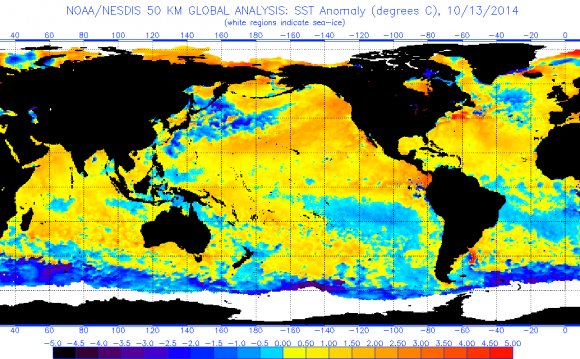
 Temperature influences the rates of many ecosystem processes. A number of recent studies have found evidence of systematic increases in Great Lakes surface water temperatures. Our study aims to construct empirical relationships between surface water temperatures and local air temperatures that can be used to estimate future water temperatures using future air temperatures generated by global climate models. Remotely sensed data were used to model lake-wide average surface water temperature patterns during the open-water period in Lakes Superior, Huron, Erie, and Ontario. Surface water temperatures typically exhibit linear warming through the spring, form a plateau in mid-summer and then exhibit linear cooling in fall. Lake-specific warming and cooling rates vary little from year to year while plateau values vary substantially across years. These findings were used to construct a set of lake-specific empirical models linking surface water temperatures to local air temperatures for the period 1995–2006. Hindcasted whole-lake water temperatures from these models compare favourably to independently collected offshore water temperatures for the period 1968–2002. Relationships linking offshore water temperatures to inshore water temperatures at specific sites are also described. Predictions of future climates generated by the Canadian Global Climate Model Version 2 (CGCM2) under two future greenhouse gas emission scenarios are used to scope future Great Lakes surface water temperatures: substantial increases are expected, along with increases in the duration of summer stratification.
Temperature influences the rates of many ecosystem processes. A number of recent studies have found evidence of systematic increases in Great Lakes surface water temperatures. Our study aims to construct empirical relationships between surface water temperatures and local air temperatures that can be used to estimate future water temperatures using future air temperatures generated by global climate models. Remotely sensed data were used to model lake-wide average surface water temperature patterns during the open-water period in Lakes Superior, Huron, Erie, and Ontario. Surface water temperatures typically exhibit linear warming through the spring, form a plateau in mid-summer and then exhibit linear cooling in fall. Lake-specific warming and cooling rates vary little from year to year while plateau values vary substantially across years. These findings were used to construct a set of lake-specific empirical models linking surface water temperatures to local air temperatures for the period 1995–2006. Hindcasted whole-lake water temperatures from these models compare favourably to independently collected offshore water temperatures for the period 1968–2002. Relationships linking offshore water temperatures to inshore water temperatures at specific sites are also described. Predictions of future climates generated by the Canadian Global Climate Model Version 2 (CGCM2) under two future greenhouse gas emission scenarios are used to scope future Great Lakes surface water temperatures: substantial increases are expected, along with increases in the duration of summer stratification.
Index words
- Climate change;
- Surface water temperatures;
- Great Lakes
YOU MIGHT ALSO LIKE












